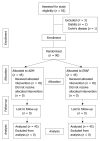Randomized controlled trial of minimally invasive surgery using acellular dermal matrix for complex anorectal fistula
- PMID: 20614483
- PMCID: PMC2900719
- DOI: 10.3748/wjg.v16.i26.3279
Randomized controlled trial of minimally invasive surgery using acellular dermal matrix for complex anorectal fistula
Abstract
Aim: To compare the efficacy and safety of acellular dermal matrix (ADM) bioprosthetic material and endorectal advancement flap (ERAF) in treatment of complex anorectal fistula.
Methods: Ninety consecutive patients with complex anorectal fistulae admitted to Anorectal Surgical Department of First Affiliated Hospital, Xinjiang Medical University from March 2008 to July 2009, were enrolled in this study. Complex anorectal fistula was diagnosed following its clinical, radiographic, or endoscopic diagnostic criteria. Under spinal anesthesia, patients underwent identification and irrigation of the fistula tracts using hydrogen peroxide. ADM was securely sutured at the secondary opening to the primary opening using absorbable suture. Outcomes of ADM and ERAF closure were compared in terms of success rate, fecal incontinence rate, anorectal deformity rate, postoperative pain time, closure time and life quality score. Success was defined as closure of all external openings, absence of drainage without further intervention, and absence of abscess formation. Follow-up examination was performed 2 d, 2, 4, 6, 12 wk, and 5 mo after surgery, respectively.
Results: No patient was lost to follow-up. The overall success rate was 82.22% (37/45) 5.7 mo after surgery. ADM dislodgement occurred in 5 patients (11.11%), abscess formation was found in 1 patient, and fistula recurred in 2 patients. Of the 13 patients with recurrent fistula using ERAF, 5 (11.11%) received surgical drainage because of abscess formation. The success rate, postoperative pain time and closure time of ADM were significantly higher than those of ERAF (P < 0.05). However, no difference was observed in fecal incontinence rate and anorectal deformity rate after treatment with ADM and ERAF.
Conclusion: Closure of fistula tract opening with ADM is an effective procedure for complex anorectal fistula. ADM should be considered a first line treatment for patients with complex anorectal fistula.
Figures
References
-
- Sainio P. Fistula-in-ano in a defined population. Incidence and epidemiological aspects. Ann Chir Gynaecol. 1984;73:219–224. - PubMed
-
- Marks CG, Ritchie JK. Anal fistulas at St Mark's Hospital. Br J Surg. 1977;64:84–91. - PubMed
-
- Hamadani A, Haigh PI, Liu IL, Abbas MA. Who is at risk for developing chronic anal fistula or recurrent anal sepsis after initial perianal abscess? Dis Colon Rectum. 2009;52:217–221. - PubMed
-
- van der Hagen SJ, Baeten CG, Soeters PB, van Gemert WG. Long-term outcome following mucosal advancement flap for high perianal fistulas and fistulotomy for low perianal fistulas: recurrent perianal fistulas: failure of treatment or recurrent patient disease? Int J Colorectal Dis. 2006;21:784–790. - PubMed
Publication types
MeSH terms
LinkOut - more resources
Full Text Sources
Miscellaneous


